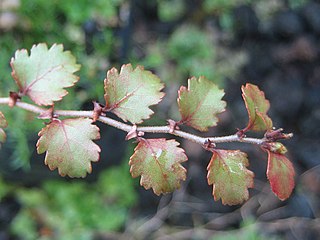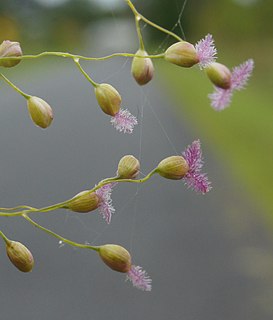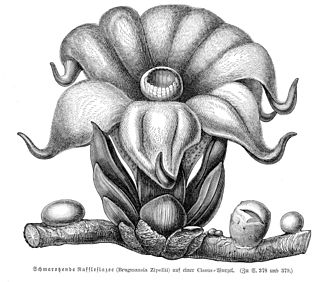
Sorghum is a genus of about 25 species of flowering plants in the grass family Poaceae. Some of these species have grown as cereals for human consumption and some in pastures for animals. One species, Sorghum bicolor, was originally domesticated in Africa and has since spread throughout the globe. Seventeen of the 25 species are native to Australia, with the range of some extending to Africa, Asia, Mesoamerica, and certain islands in the Indian and Pacific Oceans. One species is grown for grain, while many others are used as fodder plants, either cultivated in warm climates worldwide or naturalized in pasture lands. Sorghum is in the subfamily Panicoideae and the tribe Andropogoneae.

The Afrotropical realm is one of Earth's eight biogeographic realms. It includes Africa south of the Sahara Desert, the majority of the Arabian Peninsula, the island of Madagascar, southern Iran and extreme southwestern Pakistan, and the islands of the western Indian Ocean. It was formerly known as the Ethiopian Zone or Ethiopian Region.

Podocarpaceae is a large family of mainly Southern Hemisphere conifers, comprising about 156 species of evergreen trees and shrubs. It contains 19 genera if Phyllocladus is included and Manoao and Sundacarpus are recognized.

The Antarctic flora is a distinct community of vascular plants which evolved millions of years ago on the supercontinent of Gondwana. It is now found on several separate areas of the Southern Hemisphere, including southern South America, southernmost Africa, New Zealand, Australia and New Caledonia. Joseph Dalton Hooker was the first to notice similarities in the flora and speculated that Antarctica had served as either a source or a transitional point, and that land masses now separated might formerly have been adjacent.

Cunoniaceae is a family of 27 genera and about 310 species of woody plants in the order Oxalidales, mostly found in the tropical and wet temperate regions of the Southern Hemisphere. The greatest diversity of genera are in Australia and Tasmania, New Guinea, and New Caledonia. The family is also present in Central America, South America, the Caribbean, Malesia, the island of the South Pacific, Madagascar and surrounding islands. the family is absent from mainland Asia except from Peninsular Malaysia, and almost absent from mainland Africa apart from two species from Southern Africa. Several of the genera have remarkable disjunct ranges, found on more than one continent, e.g. Cunonia, EucryphiaWeinmannia sect. Weinmannia.

Digitaria is a genus of plants in the grass family native to tropical and warm temperate regions but can occur in tropical, subtropical, and cooler temperate regions as well. Common names include crabgrass, finger-grass, and fonio. They are slender monocotyledonous annual and perennial lawn, pasture, and forage plants; some are often considered lawn pests. Digitus is the Latin word for "finger", and they are distinguished by the long, finger-like inflorescences they produce.

Cenchrus is a widespread genus of plants in the grass family. Its species are native to many countries in Asia, Africa, Australia, the Americas, and various oceanic islands.

Jacobaea is a genus of flowering plants in the tribe Senecioneae and the family Asteraceae. Its members used to be placed in the genus Senecio, but have been separated into the segregate genus Jacobaea on the basis of molecular phylogenetics in order to maintain genera that are monophyletic. The following species are recognised by The Plant List:
The World Geographical Scheme for Recording Plant Distributions (WGSRPD) is a biogeographical system developed by the international Biodiversity Information Standards (TDWG) organization, formerly the International Working Group on Taxonomic Databases. The WGSRPD standards, like other standards for data fields in botanical databases, were developed to promote "the wider and more effective dissemination of information about the world's heritage of biological organisms for the benefit of the world at large". The system provides clear definitions and codes for recording plant distributions at four scales or levels, from "botanical continents" down to parts of large countries. Current users of the system include the International Union for Conservation of Nature (IUCN), the Germplasm Resources Information Network (GRIN), and the World Checklist of Selected Plant Families (WCSP).

Veldkamp's dwarf epauletted fruit bat is a species of bat in the family Pteropodidae. It is monotypic within the genus Nanonycteris. It is found in Benin, Cameroon, Central African Republic, Ivory Coast, Ghana, Guinea, Liberia, Nigeria, Sierra Leone, and Togo. Its natural habitats are subtropical or tropical moist lowland forest, subtropical or tropical mangrove forest, subtropical or tropical moist montane forest, dry savanna, and moist savanna. It is threatened by habitat loss.

Franz Thonner was an Austrian taxonomist and botanist from Vienna. In the spring of 1896, he made his first trip to the African interior to explore the botany and people in the northern part of the Congo Basin. Besides his comprehensive collection of plants, he embarked on a thorough ethnographic study of the region.

Chionachne is a genus of Asian, Australian, and Papuasian plants in the grass family.

Gerardus Mattheus Johannes "Gerard" Veldkamp was a Dutch politician of the defunct Catholic People's Party (KVP) now merged into the Christian Democratic Appeal (CDA) party and economist.

Eremochloa is a genus of Asian and Australian plants in the grass family.

Urochloa is a genus of plants in the grass family, native to Eurasia, Africa, Australia, Mexico, and the Pacific Islands. Common names include signalgrass.
Vietnamochloa is a genus of plants in the grass family. The only known species is Vietnamochloa aurea, found only in Vietnam.

Isachne is a widespread genus of tropical and subtropical plants in the grass family, found in Asia, Africa, Australia, the Americas, and various oceanic islands. They may be known generally as bloodgrasses.

Glossocardia is a genus of flowering plants in the daisy family. It is native to Asia and Australia.

Rhizanthes is a genus of four species of parasitic flowering plants in the family Rafflesiaceae. They are without leaves, stems, roots, or photosynthetic tissue, and grow within the roots of a few species of Tetrastigma vines. The genus is limited to the tropical forests of Southeast Asia. The flowers of Rhizanthes are very large, they vary from 14 to 43 cm in diameter. At least one species of Rhizanthes, Rh. lowii, is endothermic.
Ben Zonneveld is a Dutch plant scientist and botanist known for his work on the genetics of Tulips and Daffodils, and their infrageneric classification.
















